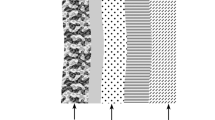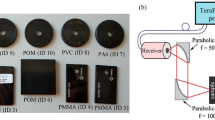Abstract
Hyperspectral images of galvanized steel plates, each containing a stain of cyclotrimethylenetrinitramine (RDX), were recorded using a commercial long-wave infrared imaging spectrometer. Demonstrations of passive RDX chemical detection at areal dosages between 16 and 90 µg/cm2 were carried out over practical standoff ranges between 14 and 50 m. Anomaly and target detection algorithms were applied to the images to determine the effect of areal dosage and sensing distance on detection performance for target RDX. The anomaly detection algorithms included principal component analysis, maximum autocorrelation factors, and principal autocorrelation factors. Maximum difference factors and principal difference factors are novel multivariate edge detection techniques that were examined for their utility in detection of the RDX stains in the images. A target detection algorithm based on generalized least squares was applied to the images, as well, to see if the algorithm can identify the compound in the stains on the plates using laboratory reflection spectra of RDX, cyclotetramethylenetetranitramine (HMX), and 2,4,6-trinitrotoluene (TNT) as the target spectra. The algorithm could easily distinguish between the nitroaromatic (TNT) compound and the nitramine (RDX, HMX) compounds, and, though the distinction between RDX and HMX was less clear, the mean weighted residuals identified RDX as the stain on the plate. Improvements that can be made in this detection technique are discussed in detail. As expected, it was found that detection was best for short distances and higher areal dosages. However, the target was easily detected at all distances and areal dosages used in this study.







Similar content being viewed by others
References
Yinon J (2002) Trends Anal Chem 21:292–301
Yinon J (ed) (2007) Counterterrorist detection techniques of explosives. Elsevier, New York
National Research Council (2004) Existing and potential standoff explosives detection techniques. The National Academies Press, Washington
Ray MD, Sedlacek AJ, Wu M (2000) Rev Sci Instrum 71:3485–3489
Carter JC, Angel SM, Lawrence-Snyder M, Scaffidi J, Whipple RE, Reynolds JG (2005) Appl Spectrosc 59:769–775
Blanco A, Pacheco-Londono LC, Pena-Quevedo AJ, Hernandez-Rivera SP (2006) Proc SPIE 6217:621737
Van Neste CW, Senesac LR, Yi D, Thundat T (2008) Appl Phys Lett 92:134102
Van Neste CW, Senesac LR, Yi D, Thundat T (2008) Appl Phys Lett 92:234102
De Lucia FC Jr, Gottfried JL, Munson CA, Miziolek AW (2008) Appl Opt 47:G112–G121
Pearson GN, Harris M, Willetts DV, Tapster PR, Roberts PJ (1997) Appl Opt 36:2713–2720
Schollhorn C, Fuller AM, Gratier J, Hummel RE (2007) Appl Opt 46:6232–6236
Schultz JF, Taubman MS, Harper WW, Williams RM, Myers TL, Cannon BD, Sheen DM, Anheier NC, Allen PJ, Sundaram SK, Johnson BR, Aker PM, Wu MC, Lau EK (2003) Proc SPIE 4999:1–18
Steinfeld JI, Wormhoudt J (1998) Annual Rev Phys Chem 49:203–232
Thériault J-M, Puckrin E, Hancock J, Lecavalier P, Lepage CJ, Jensen JO (2004) Appl Opt 43:5870–5885
Farley V, Vallieres A, Chamberland M, Villemaire A, Legault JF (2006) Proc SPIE 6398:63980T
Sharpe SW, Johnson TJ, Sams RL, Chu PM, Rhoderick GC, Johnson PA (2004) Appl Spectr 58:1452–1461
Johnson TJ, Sams RL, Blake TA, Sharpe SW, Chu PM (2002) Appl Opt 41:2831–2839
Farley V, Chamberland M, Vallieres A, Villemaire A, Legault J-F (2006) Proc SPIE 6206:62062A
Johnson TJ, Roberts BA, Kelly JF (2004) Appl Opt 43:638–650
Jackson JE (1991) A user’s guide to principal components. Wiley, New York
Green AA, Berman M, Switzer P, Craig MD (1988) IEEE Trans Geosci Remote Sens 26:65–74
Martens H, Næs T (1989) Univariate calibration. Wiley, New York
Turin GL (1960) IRE Trans Inform Theory 6:311–329
Burr T, Hengartner N (2006) Sensors 6:1721–1750
Grahn HF, Geladi P (eds) (2007) Techniques and applications of hyperspectral image analysis. Wiley, New York
Savitzky A, Golay MJE (1964) Anal Chem 36:1627–1639
Boyd RW (1983) Radiometry and the detection of optical radiation. Wiley, New York
Scharlemann ET (2003) Proc SPIE 5154:126–137
Warren DW, Hackwell JA, Gutierrez DJ (1997) Opt Eng 36(4):1174–1182
Acknowledgements
The authors would like to thank Vincent Farley and Jean-Pierre Allard of Telops, Inc. for help with LW-FIRST rental, service, and training logistics.
The experimental research described here was performed at the Pacific Northwest National Laboratory (PNNL), which is operated for the US Department of Energy by the Battelle Memorial Institute under contract number AC05-76RL0 1830. This research was supported by PNNL’s Laboratory-Directed Research and Development, Initiative for Explosives Detection portfolio. The authors would like to thank the Initiative’s director Dr. David A. Atkinson for his interest and support of this work and Dr. John Hartman for his comments on the manuscript.
Author information
Authors and Affiliations
Corresponding author
Electronic supplementary material
Below is the link to the electronic supplementary material.
ESM 1
(PDF 1906 kb)
Rights and permissions
About this article
Cite this article
Blake, T.A., Kelly, J.F., Gallagher, N.B. et al. Passive standoff detection of RDX residues on metal surfaces via infrared hyperspectral imaging. Anal Bioanal Chem 395, 337–348 (2009). https://doi.org/10.1007/s00216-009-2907-5
Received:
Revised:
Accepted:
Published:
Issue Date:
DOI: https://doi.org/10.1007/s00216-009-2907-5




